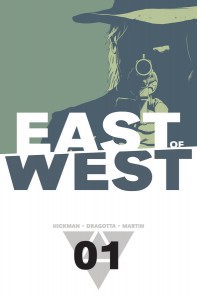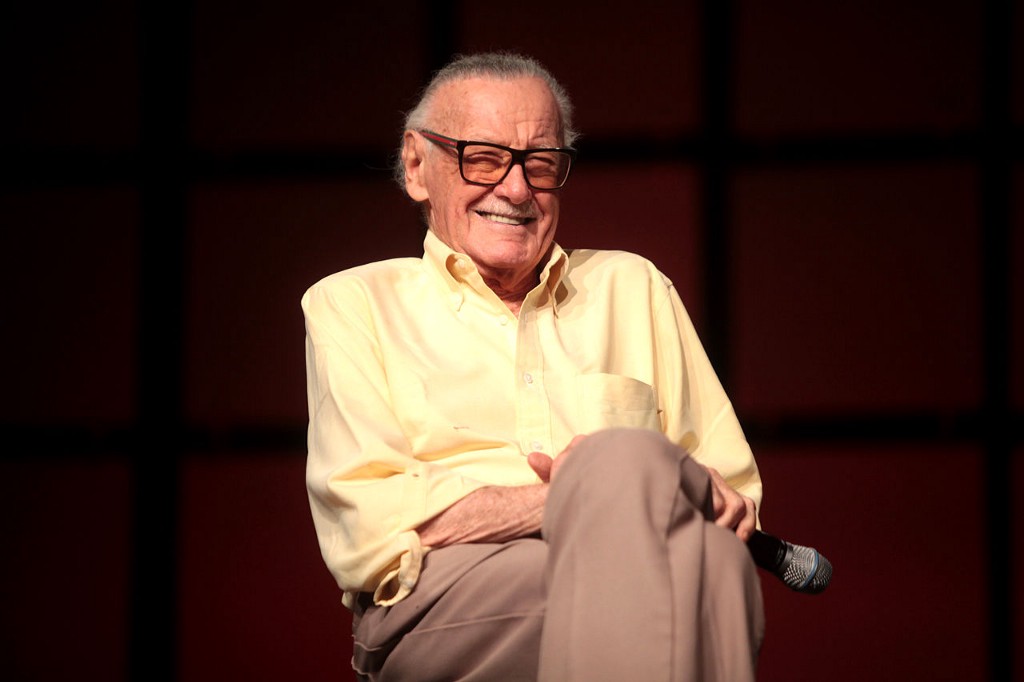Books & Culture
Love and Death in the Mythical West

Of course there are archetypes. Death looms large, as does the allure of the frontier. There are hastily-assembled communities; there are shady establishments on the fringes of society. There is Death, and Death has found love, and things have gone horribly wrong from there. There’s a heady dose of the surreal present in the narrative unfolding, blending elements modern and archaic. As much as it’s a story set in the West, it’s also a story about stories set in the West. And rising above it all: the terror of that figure that brings mortality, and the way that mythologies loom large.

The paragraph above could be referring to Jonathan Hickman and Nick Dragotta’s ongoing comic East of West. It could also be describing Kelly Sue DeConnick and Emma Rios’s ongoing comic Pretty Deadly. At present, two collections of the former have been released, The Promise and We Are All One, while the first volume of Pretty Deadly has the evocative title of The Shrike. Also notable: these comics are, otherwise, nothing alike, save for the level of quality found in both. Reading them, however, is a powerful lesson in how some of the same thematic elements can be used by different storytellers in vastly different ways.
Jonathan Hickman made his name as a writer based on high-concept work. His The Nightly News was a satire of media excesses laced with a paranoid conspiracy thriller, while Pax Romana involved a near-future Vatican sending soldiers back in time two millennia to forever alter the course of history. East of West is a deeply accelerated work, and there are about a dozen concepts here which could each stand on their own. It’s set midway through the 21st century–but it’s the future of an alternate timeline, where the Civil War dragged on for decades, fragmenting the United States into seven nations long ago. Also, the Four Horseman of the Apocalypse are running around–well, three of them are, in the forms of particularly vicious children, hoping to hasten the end of the world. Death, on the other hand, is in search of vengeance for the seeming death of his wife; as the series opens, he’s in the midst of hunting down those responsible. Magic, advanced technology, bizarre cityscapes, and a horrific scene involving a sentient eyeball are all a part of the proceedings.
Magic, advanced technology, bizarre cityscapes, and a horrific scene involving a sentient eyeball are all a part of the proceedings.
If East of West is science fantasy cranked up to eleven, Pretty Deadly is something entirely different. DeConnick’s comics work has included everything from working on translations of Japanese series to horror and superhero work. And rather than borrowing familiar conventions, Pretty Deadly sets up its own occasionally roundabout way of storytelling. Or, in its case, storytelling within storytelling: in a memorable touch, The Shrike is framed as an exchange of dialogue between a butterfly and the skeleton of a rabbit. Gradually, they lay out a story about more storytellers: a troupe who comes to an isolated Old West town and recounts the tale of Deathface Ginny, a gunslinger whose father happens to be, well, Death himself. And while Ginny is the story’s central figure, this isn’t readily apparent: there’s a long buildup to her first appearance, and she remains (as gunslingers tend to be) taciturn, stoic, inherently unknowable. Depending on where the series goes from here, The Shrike could be read as an origin story or a kind of founding myth. Nearly all of the characters emerge from it changed in some way, and it seems entirely possible that future volumes will be radically different from this one, reinventing the series as they go.

The plot of The Shrike settles on Ginny’s pursuit of Fox, a blind storyeller, and his young charge Sissy, whose stories eventually reveal mythic roots. And while the story being told incorporates traditional Western settings like frontier towns and duels with sprawling landscapes behind the participants, the expected can quickly shift into a surreal. A fight to the death ends with one of the participants transforming into a flock of butterflies; a grieving husband digs a grave but, in his madness, refuses to stop, and so enters the realm of Death. The design for Death in the series is also notable for its nods to, and defiance of, tradition: a black-garbed human figure, yes, but with a beaverlike skull as the head.
DeConnick does a fine job in making these characters fascinating: nearly all of the characters with dialogue are presented sympathetically, even if their roles in the story are antagonistic. For East of West, a larger divide between heroes and villains exists. The heroic figures there are largely stoic: Death and the two magicians who accompany him, along with a Texas Ranger carrying out a mission beginning in We Are All One, do the majority of their work in silence. Death’s bride, Xiaolain, is the series’s most complex character–and, politically, one of its most powerful. (Her father is Mao V, which I genuinely hope is a sign that Hickman is a DeLillo reader.) The more antagonistic characters have a more grotesque aspect–sometimes in the Sherwood Anderson sense of the word. Sometimes, this can be taken literally: one minor character ends up fused with a demonic creature, in panels that feature some of Dragotta’s most viscerally unsettling work. There’s also a head of state allied with the Horsemen named Antonia LeVay.
East of West is a bold work of storytelling: at various points, large arrays of guns are fired, Death charges into battle on a robotic horse, and Xiaolain crushes an adversary’s skull. The pace is frenetic, the scale is huge, and the tone is at times intentionally over-the-top. Then again, this is the story of factions attempting to hasten and prevent the apocalypse; a subtler approach, such as the one seen in Hickman’s insular time travel story The Red Wing, might not have worked nearly as well. Here, he seems to be pushing against his own fondness for high concepts, throwing numerous ideas into the mix with each new plot development.
In keeping with the preponderance of storytelling in Pretty Deadly, DeConnick echoes the fundamental weirdness of reading comics in the late 80s and early 90s, when a generation of British science fiction authors made their mark on American comics. There’s probably an essay that could be written about how Neil Gaiman’s work on Sandman introduced a host of readers to the concept of metafiction–and while DeConnick’s writing doesn’t feel derivative of the likes of Gaiman or Alan Moore, there’s certainly similarity to the way that all three introduce mythical elements into their work. DeConnick’s work here certainly evokes that, but she’s worked out her own grammar. It doesn’t hurt that Rios’s art falls in the tradition of Paul Pope: in other words, art that takes influence from traditions all over the globe, and can therefore veer from the kinetic to the dreamlike and back in the span of a few pages. The panel layout constantly shifts as well, blending foreground and background, literal and metaphorical.
The panel layout constantly shifts as well, blending foreground and background, literal and metaphorical.
Both Pretty Deadly and East of West are ongoing series, and so tones and styles may change as they evolve. But the way in which they have emerged so far has been a fascinating study in contrasts. Though each features ruminations on life, death, and destiny, the tone used in the former is subtler–though it does feature its share on gunfights and shed blood. The latter is wonderfully over-the-top, a search to top itself with quieter moments amid the chaos. And despite their differences in tone, there’s plenty to admire in both works.








